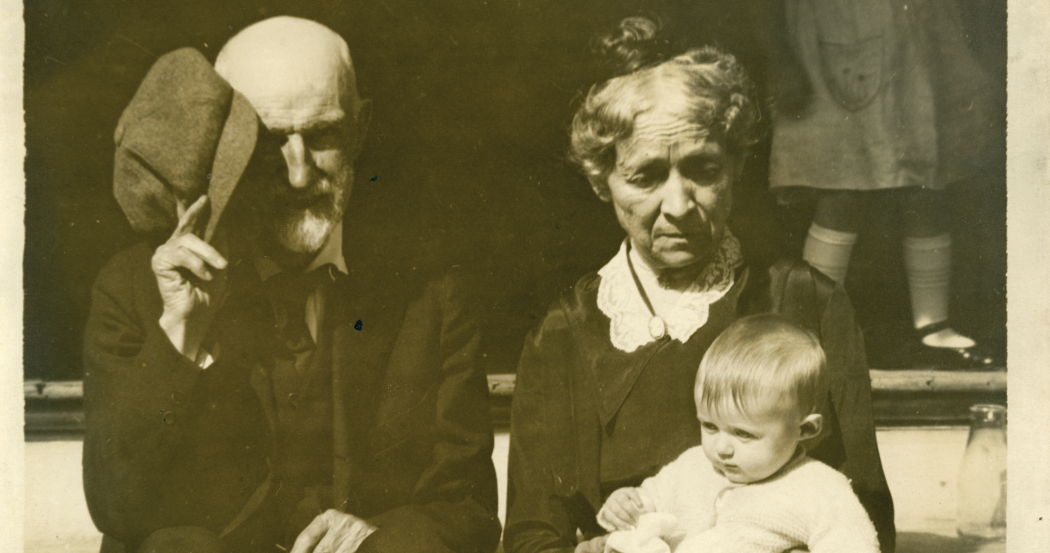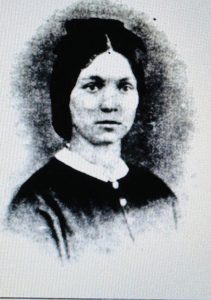
Mrs. Root in her teens
Mrs. Susan Hall Root
By: Nina Bagley
Susan Hall was born in 1841 in Ely, Cambridgeshire, England. Her parents were Daniel and Mary Hall, both born in England. They had three children: Robert born in 1838, Susan born in 1841 and, after immigrating to America in 1848, Mary born in 1850. During 1815 and 1837, Ely was in general depression, an agricultural community with no work to be found. The townspeople had terrible living conditions and Ely laborers could no longer maintain themselves. The city of Ely’s population was growing more rapidly than it was in the surrounding countryside. Infectious diseases plagued the countryside, then another Cholera outbreak began in England in 1848. There was a heavy death rate, increasing mortality between 1841 and 1848. This might be one of the reasons why Susan’s father decided to embark on a journey to America with his family for better opportunities.
In 1848, Liverpool, England was the most significant immigration port in the world. Traveling from Ely, Cambridgeshire to Liverpool was 250 miles. Once arriving at the port, families waited in lines, sometimes for days just to get on a ship to sail to America. The journey could take forty to ninety days (about three months) with unfavorable winds and harsh weather.
When this occurred, passengers would often run short of food. Bread, biscuits and potatoes were provided by the shipping companies. The food was terrible and, at times, spoiled.
This was not a cruise ship. Passengers had about two square feet of space. It was dirty, with extraordinarily little ventilation, not to mention lice and rodents. It was a long, wearying journey for a young girl of eight, not knowing what the future would bring, leaving her homeland for an unfamiliar land.
Susan’s father decided to farm and raise his family in Medina County, Ohio. In the new homeland, the family prospers and became community members, attending church and farming their land. As a young girl, Susan had no idea that she would grow up to be a driving force in one man’s life or that that man would become a part of history in Medina, Ohio, the place her father would choose to bring his family to have a better life.
As a young girl, Susan had a schoolmate named Sara Root who was very fond of Susan. Sara felt that her friend Susan would make a good wife for her brother. Sara’s brother Amos Ives Root was away for the Winter in Westville, Ohio, on the river, staying with a relative while attending high school. Sara wrote to her brother saying she had found one of the sweetest girls in all the world as a wife for him.
It was a little embarrassing for Amos I. Root when the two first met, knowing that this schoolmate of his sister knew what she had written to him. It was true love at first sight for both.
A.I. Root wrote: “Her honest simplicity and childlike innocence impressed me from the very first; and, as a matter of course, we two proceeded to get acquainted; and I, for my part, I fear, carried out the program so well that the dear sister was a good many times forgotten and ‘left out in the cold’” (Gleanings in Bee Culture, 1923, pg. 58).
Amos would walk miles to Susan’s family’s farm in unbearable weather to spend a few hours in her company. He called on her once in the middle of the week and every Sunday night! Both Amos and Susan were attending school at the time. When visiting in those early days, staying late was much the fashion. Susan would politely tell Amos that her father went to considerable expense so she could attend a particular school for girls. She could not participate in her studies if he stayed so late, and how important it was for her to get a good night’s sleep. Amos was reluctant to go home at the proper time. Finally, Susan said one evening: “Sir, it is time for you to go home.”
Amos was offended and declared that if he went home, he would go and never return. Susan said, “All right. If you refuse to listen to the dictates of good common sense, it will probably be better for both of us that you should go away and never come back” (Gleanings in Bee Culture, Jan. 1923).
Susan was petite with a kind spirit who knew exactly who she was and what she desired. Having their first lover’s quarrel, Amos left with his head up high and a stern look to teach her that he, Amos I. Root, was not to be dictated to in that manner!
It was a dark night, and he was walking quickly. His temper was getting the best of him and flaring up, which it had done most of his life. Amos started reflecting on how he acted and started to slow down a bit. It was the voice of reason or remembrance of his good mother’s teachings. This is what his mother said: “Old Fellow, is it not possible you are taking offense at the wise words of the best friend you have on earth, and that, instead of being offended, you should recognize her as the one whose price is far above rubies?” (Gleanings in Bee Culture, Jan. 1923.)
Amos crossed the bridge, realizing his mistake. He felt a cold chill all over him, and he turned around, walking calmly back to Mr. Hall’s farm as he hurried up to the house he had just left. Above the front door was Susan’s window to her room. He picked up a pebble and gently tossed it up against her window. And the window went flying up just as he expected! He was always quite sure of himself, so this is what Amos I. Root said: “‘Sue, I humbly beg pardon. You were right, and I was wrong. Will you forgive me?’ Susan responded, ‘All right. Good night.’ And down went the window!” (Gleanings, Jan. 1923).
Amos thought she would come downstairs and give him a kiss of reconciliation; Susan planned nothing of the kind! It was a turning point in his life. Amos finally proposed that the two should be engaged. But Susan insisted that they both were too young to be getting married; Amos was 17 and Susan was 15. Kindly, she told Amos that he did not have the vitality for marriage. A.I. Root was sickly and frail as a child and as a man was not strong. She wanted to postpone marraige for a few years because she was not ready for marriage and wanted to complete her schooling.
A.I. Root would go off and find his way in the big wide world for the next couple of years, making a name for himself, giving lectures and expanding his mind to innovative ideas. He never let the idea go, knowing the two would marry one day. After his lecture tours were over. He returned to his father’s small farm in the woods where he lived as a young man.
Susan’s father feared that Amos could not make a living. Amos would prove him wrong. A.I. Root took a course in watch-repairing and, at twenty-one, started a watch-repairing shop under the pretentious name of A.I. Root & Co. He then proceeded to call on his true love, Miss Susan Hall. Susan’s father was humbled, and he approved them of their marriage.
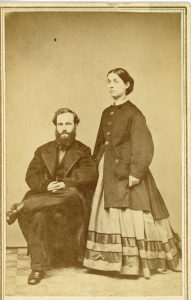
Mr. and Mrs. Root after they were married.
Three noteworthy events took place in 1861. Abraham Lincoln’s inauguration on March 4, 1861. The Civil War started on April 9, 1861. And, A.I. Root and Susan Hall were married on September 29, 1861. Amos was twenty-one and Susan was nineteen years old.
As the sun rose that Autumn morning after Mr. and Mrs. Root married, they started with horses and carriage on a honeymoon trip. The two were by themselves. Amos put out his hand to Sue as he called her, and she looked smilingly up into his face while he spoke, “Sue, the agreement between us two that we have just entered into is the most sacred and solemn step in our lives. Let us fully consider the new relations that rest on the shoulders of both of us, and may God help us to bear with each other and to bear with patience the new responsibilities that are going to rest on us two. May we two, through thick and thin, for better or for worse, cling to each other.” It was a boyish speech, but it was honest.
Mrs. Susan Hall Root would become his support, “wise counselor” and confidante throughout their marriage, including her husband’s business affairs. Mrs. Root’s hard work and excellent management of the home helped A.I. Root to meet his obligations when they were starting out as a young couple. They would build a homestead and live in Medina, Ohio.
A.I. Root would become a very influential man in many ways, especially in the world of bees. By 1885, the Root name was recognized around the world. Modest and simple in taste, Mrs. Root always avoided publicity, preferring the background of a beautiful home life she had with her husband and children.
Mrs. Root would spend the next sixty years being there for her husband while being an attentive wife and mother, giving birth to five children in twenty years: Ernest R. Root, 1862; Maud E. Root, 1865; Constance M. Root, 1872; Carrie B. Root, 1878; and, having her youngest child at forty-one, Huber Hall Root, 1883. The two would cling together for better or worse, just as they promised one another.
In August 1865, a swarm of bees passed over the A.I. Root & Co. One of the employees of Mr. Root asked jokingly what would you give me if I caught the swarm? Mr. Root replied, a dollar securely boxed. The young man brought A.I. Root the bees, securely boxed, and collected his dollar; the rest is history.

The Root Factory.
A.I. Root founded his bee company in 1869 in his hometown of Medina, Ohio to manufacture beehives and beekeeping equipment. The company was shipping four railroad freight cars of beekeeping equipment everyday, things were going well! A.I. Root was working sixteen-hour days, which sometimes made it difficult to be around him. He started the magazine Gleanings in Bee Culture on January 1, 1873. The first edition of A.I. Root’s book ABC and XYZ of Bee Culture was published in 1879.
Mr. Root constantly worked and expected everyone around him to work just as hard! But that was impossible because Mr. Root was continually working and doing the work of five men until he would exhaust himself to the point that he made himself ill.
Mr. Root would say: “Had I gone on as an evil and angry spirit prompted me to do and not turn back to apologize to my dear wife, Sue, there would have been no A.I. Root Co. There would have been no five dear children brought up in the fear of the Lord, and there would, in all probability, have been no A.I. Root now dictating these words” (Gleanings in Bee Culture, Jan.1923).
Mrs. Root’s children, at some point, all worked for the family business. She was a devoted mother and the most meticulous housekeeper; dust and dirt were her enemies!
Mrs. Root’s daughter Candice Root Boyden authored an article in Gleanings about her mother. The title was “Mother”: “Sweet and modest as the violet of her nature England. Mother always kept herself in the background; only her husband and children, no matter how much credit they had accomplished, should go to her” (Gleanings in Bee Culture, Jan. 1, 1922).
Candice remembered how, as a small child, her mother spent most of her time in the kitchen preparing delicious, healthy foods for the family. Mrs. Root would spend many hours standing over a walnut table with drop leaves while she prepared the family meals. At the end of the table was a shallow drawer to put spoons, cutlery, and other kitchen items. But Mrs. Root would use the drawer for more important things. Neatly filled with toys, the drawer’s contents revealed her love and understanding of a child’s nature.
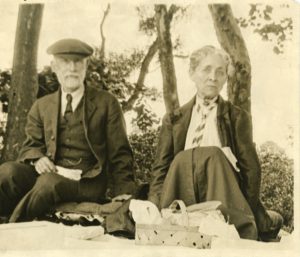
Mr. and Mrs. Root having a picnic.
The toys were not store-bought, as her daughter would say they were “Treasures, queer bits of metal and wood, an old steel puzzle made by Father, rubber balls, balls of string, little wooden boxes and a little shallow bowl carved from black walnut. But unselfishness, Mother’s dominant characteristic, is revealed in the fact that the drawer, within my recollection, never held anything to help Mother in her work and save her steps.” (Gleanings in Bee Culture, Jan. 1, 1922).
At the time, kitchens were compact, with all their cooking utensils and drawers close by to save the women steps in the kitchen. Mrs. Root was okay with the drawer, which was full of toys for the children. And she did not mind walking back and forth to the big pantry each time she needed something out of it. Mrs. Root often had very severe attacks of pleurisy throughout her life, weakening her heart. She was not a robust woman and sometimes did not have the energy to run around after the children, so the drawer kept their little hands busy and close to their mother.
Mrs. Root would fill a bowl with water and place it on the floor so the children could sail their boats. In the Winter, she would warm the water so their little hands would not get cold. She loved children and had a nurturing way with them.
Mrs. Root did not have the opportunity to attend college, but she took immense pleasure in her children and grandchildren attending college.
Mr. and Mrs. Root would not accompany their family to hotel dinners. They would not go to formal dinners or parties in their honor, but they loved simple picnics in the parks with family around them.
In 1901, A.I. Root built a cabin in the northern part of the Michigan woods and went there to live with his wife. In the forty years of married life, they would finally work side by side, enjoying each other’s companionship.
A.I. Root did not like wintry weather; the cold bothered him. So, a few years after they built their Michigan cabin, they would make another cabin in Florida, where they spent their Winters. Mrs. Root did not like calling it a cabin, so she called it their cottage.
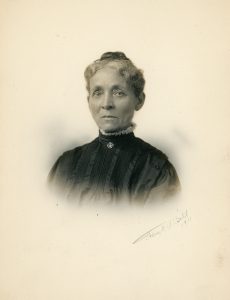
The Roots in their 70s.
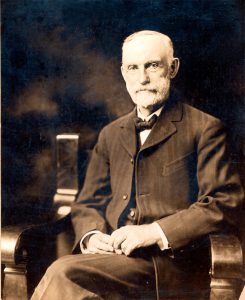 The fare from Cleveland, Ohio to Bradenton, Florida was $57.15 a tourist for a round-trip ticket for the Winter. The Roots loved going to their Florida cottage, but Mrs. Root was always overwhelmed with grief to leave all her children, grandchildren and great-grandchildren every Winter.
The fare from Cleveland, Ohio to Bradenton, Florida was $57.15 a tourist for a round-trip ticket for the Winter. The Roots loved going to their Florida cottage, but Mrs. Root was always overwhelmed with grief to leave all her children, grandchildren and great-grandchildren every Winter.
In the early 1900s, they would spend their Summers in Michigan and Winters in Florida.
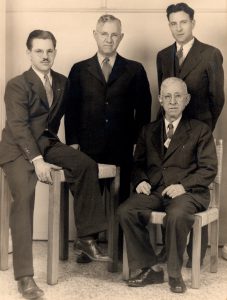
The Root Men: J.T. Calvert, Huber, Allen and Ernest Root.
Their sons, Ernest and Huber, were involved in the business of the A.I. Root Company along with their daughter Maude’s husband J.T. Calvert who was the bookkeeper. Around 1900, Ernest took over as editor for Gleanings and kept the bee part of the company going while Huber, more of an inventor like his father, experimented with beeswax. Under Huber’s guidance, the Root company started making candles at the request of the Catholic Church. The local priest was looking for better quality beeswax for their candles and a wick that burned longer. A.I. Root’s sons were carrying the torch for their father so he never had to worry about money again and could devote his time to Mrs. Root, the Congregational Church, family, bees and gardening.
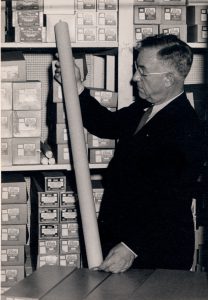
Huber started the candles for the Catholic Church.
Mrs. Root, being in her seventies, enjoyed being outdoors, working in her garden in Florida, and enjoyed spending time with her husband. She enjoyed picking vegetables from her garden and sharing them with her family and neighbors.
Her children felt their mother was the most perfect and unselfish of anyone they had ever known. Mrs. Root captured the hearts around her. She had enough love to go around and was happy when she could help those that were needy, lonely, widowed or fatherless.
Her tender heart cared for the neighbor’s chickens, cats and dogs and ensured they were all fed and cared for. And if Mrs. Root felt a horse was being mistreated, she would not stand for it. This most definitely caused her misery.
A.I. Root wrote: “May I be pardoned for saying that the dear little woman has most faithfully kept her part of the pledge year in and year out? Oh! What would I give if I could truthfully say, ‘I have done as well, or even approximately as well?’” (Gleanings in Bee Culture, 1917, pg. 297).
Mrs. Root suddenly passed away on the evening of Tuesday, November 29, 1921 in Bradenton, Florida, where she and her husband had maintained a cottage for several years. The Roots had just returned to Florida a few weeks before her death. She was feeling exceptionally well and was particularly happy to visit her good friend for many years, Mrs. Ed Nettleton of Medina, who also vacationed in Bradenton, Florida, for the Winter.
Although the family knew it was coming for some time, her life was swiftly ended; the family felt it was due to her arteries being weak from pleurisy attacks over the years.
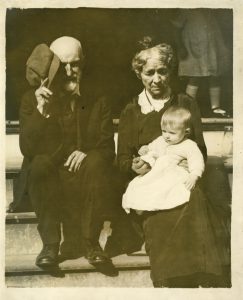
Mr. and Mrs. Root with a grandchild.
Mrs. Root’s aged husband was too feeble and was advised not to make the long trip back home with the body of his long-time companion.
Mrs. Root’s funeral was held at the home of Ernest Root, her son, on Friday, December 2, 1921, at the old homestead. Mrs. Root was eighty years old. Mr. and Mrs. Root had their sixtieth wedding anniversary a few weeks before her death. She left behind her husband, five children, eleven grandchildren and four great-grandchildren. Mrs. Root was a Medina County, Ohio resident for over seventy years and a friend to all. Mrs. Root is buried in the Spring Grove Cemetery in Medina County, Ohio.
A few years later, Mr. Root caught pneumonia on his way home to Medina, Ohio from Bradenton, Florida. Being feeble, weak and bedridden for several days, the doctor was called, but Mr. Root, knowing it was time, looked at his son Ernest one last time, feeling at peace. He was ready to meet his maker and join his true love, Mrs. Susan Hall Root. A.I. Root took a deep breath and passed away on April 29, 1923, with his children by his side. A.I. Root is buried beside his wife in the Spring Grove Cemetery in Medina County, Ohio.
Ten to twenty percent of the people fleeing Europe in the 1800s did not survive. Not only did Mrs. Root survive, but she survived childbirth, raising five children, cooking and cleaning, washing and ironing in the mid-1800s, and tending to a husband who was constantly inventing and taking chances.
Mrs. Root’s children would have children, and their children would have children, and it has continued for five generations.
The A.I. Root Company is still in business today. The magazine is still being published but instead of Gleanings in Bee Culture it is called Bee Culture: The Magazine of American Beekeeping. Today, A.I. Root is the largest supplier of liturgical candles for Catholic churches. A hundred and fifty-four years later, Brad Root continues the family tradition like his father and grandfathers before him. He is the fifth generation of the Root family. So, the next time you light a Root Candle, think of Mrs. Susan Hall Root who was a friend to all.
I agree with A.I. Root that there would be no A.I. Root Co. if not for a tenacious young girl, Susan Hall Root!
“There is a great woman behind every great man.”
Nina Bagley
Ohio Queen Bee
Columbus, Ohio






